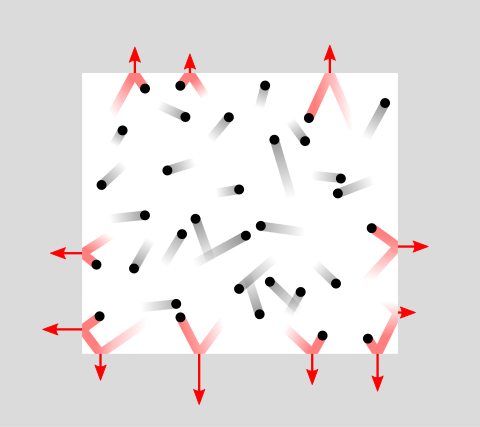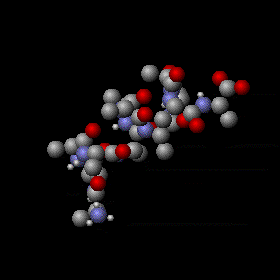Kinetic energy and molecular speeds of gases form the kinetic theory of gases. This theory describes the behavior of gases at the molecular level, connecting macroscopic properties like pressure and temperature with microscopic phenomena such as molecular motion.

Kinetic Energy of Gas Molecules
Kinetic energy is the energy associated with the motion of an object. For gas molecules, it is the energy they possess due to their random, continuous movement.
According to the kinetic theory of gases:
Gas molecules are in constant and random motion. It is colliding with each other with the walls of their container.
The temperature of a gas is a measure of the average kinetic energy of its molecules.
The kinetic energy (Ek) of a single gas molecule is given by:
Ek = 1/ 2mv2
where m is the mass of the molecule and v is velocity.
For a large number of gas molecules, the average kinetic energy per molecule is related to the temperature (T) of the gas:
Ek = 3 / 2 kBT
Here, kB is the Boltzmann constant (1.38×10−23 J/K).
Above equation shows that the average kinetic energy is directly proportional to the absolute temperature of the gas. When the temperature increases, the kinetic energy of gas molecules also increases, leading to faster molecular speeds.

Molecular Speeds of Gases
Gas molecules move at varying speeds due to the random nature of their collisions and interactions.
For describing these speeds, there are three key statistical measures are used:
1.Root Mean Square Speed (vrms): The root mean square speed is the square root of the mean of the squares of the molecular speeds.
It is mathematically expressed as:
(Vrms)2 = 3kBT / m = 3RT / M
Here, R is the universal gas constant
(8.314 J/mol \ cdotpK ),T is the temperature, and M is the molar mass of the gas.
vrms provides an idea of the average speed of gas molecules and is closely related to the energy possessed by them.
2. Average Speed (vavg): The average speed is the arithmetic mean of the speeds of all gas molecules.
It is expressed by:
(Vavg)2= 8 RT / πM
This speed is slightly less than Vrms, as it is not weighted by the square of the speed.
3. Most Probable Speed (Vmp): The most probable speed is the speed at which the maximum number of gas molecules is moving. It is derived from the Maxwell-Boltzmann distribution and expressed as:
(Vmp)2 = 2RT / M
This speed represents the peak of the molecular speed distribution curve.
Relationship Among Speeds
For an ideal gas, these speeds follow a specific order:
Vmp < Vavg < Vrms
This relationship arises from the statistical nature of molecular motion, with vrms being the highest due to its dependency on the square of speeds.
Maxwell-Boltzmann Distribution
The Maxwell-Boltzmann distribution graphically represents the spread of molecular speeds in a gas at a given temperature. The distribution curve is bell-shaped.
The peak corresponding to vmp.
The average speed slightly shifted to the right of the peak.
The Vrms further to the right.
As temperature increases, the distribution roll out and broadens, indicating that more molecules achieve higher speeds.
Suggestion in Real-Life and Applications
1.Pressure of Gases: The collisions of gas molecules with container walls generate pressure. The greater the molecular speed, the higher the pressure.
2. Diffusion: Gases with higher molecular speeds diffuse faster e.g hydrogen diffuses more rapidly than oxygen due to its lighter molar mass.
3. Temperature Dependence: Gas behaviors like expansion and reaction rates are influenced by molecular speeds, which are temperature-dependent.
Main points to be remember for Maxwell-distribution of speeds :-
Maxwell and Boltzmann have shown that actual distribution of molecular speeds depends on temperature and molecular mass of a gas.
On increasing the temperature most probable speed increases.
Speed distribution also depends upon mass of molecules. At the same temperature, gas molecules with heavier mass have slow speed than lighter gas molecules.
For example, at the same temperature lighter nitrogen molecules move faster than heavier chlorine molecules. Hence, at any given temperature, nitrogen molecules have higher value of most probable speed than the chlorine molecules.
At a particular temperature the individual speed of molecules keeps changing, the distribution of chlorine remain same.
Note,
Kinetic energy and molecular speeds of gases provide dynamic behavior of gas molecules. These principles not only explain the physical properties of gases but also establish connections with thermodynamics and statistical mechanics.
Kinetic energy of a gas molecule is the energy it possesses due to its motion. It is mathematically expressed as Ek =1 / 2mv2, where m is the mass of the molecule and v is its velocity. The average kinetic energy of a gas molecule is directly proportional to the temperature of the gas and is given by Ek = 3 / 2kBT where kB is the Boltzmann constant, and T is the absolute temperature.
The three types of molecular speeds in gases are:
Root Mean Square Speed (vrms): The square root of the mean of the squares of the molecular speeds.
Average Speed (vavg): The arithmetic mean of all molecular speeds.
Most Probable Speed (vmp): The speed at which the maximum number of gas molecules is moving.
The molecular speeds are calculated using the following formulas:
Root Mean Square Speed: (Vrms)2 = 3kBT / m = 3RT / M
Average Speed: (Vavg)2= 8 RT / πM
Most Probable Speed: (Vmp)2 = 2RT / M
Here, R is the universal gas constant, T is the temperature, and MMM is the molar mass of the gas.
For any ideal gas, the speeds follow the relationship:
vmp < vavg < vrms
This is because vrms accounts for the squares of velocities, which amplify higher speeds, making it the largest value.
The Maxwell-Boltzmann distribution is a statistical representation of the distribution of molecular speeds in a gas. It shows:
The most probable speed (vmp) at the peak of the curve.
The spread of molecular speeds at a given temperature.
As the temperature increases, the curve flattens and broadens, indicating higher molecular speeds.
Temperature directly affect molecular speeds. As the temperature of a gas increases:
The average kinetic energy of gas molecules rises.
The vrms,vavg, and vmpp all increase, indicating faster molecular motion.
Molecular speeds play a critical role in various phenomena:
Gas pressure: Faster molecular motion leads to higher pressure.
Diffusion and effusion: Gases with higher molecular speeds diffuse and effuse more rapidly.
Reaction rates: Faster molecular speeds at higher temperatures often result in increased reaction rates in chemical processes.